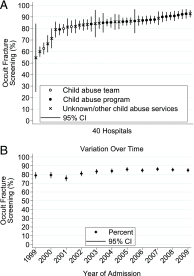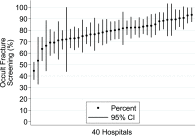Variation in occult injury screening for children with suspected abuse in selected US children's hospitals
- PMID: 23071208
- PMCID: PMC4074645
- DOI: 10.1542/peds.2012-0244
Variation in occult injury screening for children with suspected abuse in selected US children's hospitals
Abstract
Objective: To describe variation across selected US children's hospitals in screening for occult fractures in children <2 years old diagnosed with physical abuse and in infants <1 year old who have injuries associated with a high likelihood of physical abuse.
Methods: We performed a retrospective study of children <2 years old with a diagnosis of physical abuse and infants <1 year old with non-motor vehicle crash-associated traumatic brain injuries or femur fractures admitted to 40 hospitals within the Pediatric Hospital Information System database from January 1, 1999, to December 31, 2009. We examined variation among the hospitals in the performance of screening for occult fractures as defined by receipt of skeletal survey or radionuclide bone scan. Marginal standardization implemented with logistic regression analysis was used to examine hospital variation after adjusting for patient demographic characteristics, injury severity, and year of admission.
Results: Screening for occult fractures was performed in 83% of the 10,170 children <2 years old with a diagnosis of physical abuse, 68% of the 9942 infants who had a traumatic brain injury, and 77% of the 2975 infants who had femur fractures. After adjustment for patient characteristics, injury severity, and year of admission, hospitals varied significantly in use of screening for occult fractures in all 3 groups of children.
Conclusions: The observed variation in screening for occult fractures in young victims of physical abuse and infants who have injuries associated with a high likelihood of abuse underscores opportunities to improve the quality of care provided to this vulnerable population.
Figures



Similar articles
-
Skeletal surveys in young, injured children: A systematic review.Child Abuse Negl. 2018 Feb;76:237-249. doi: 10.1016/j.chiabu.2017.11.004. Epub 2017 Nov 15. Child Abuse Negl. 2018. PMID: 29154020 Free PMC article.
-
Evaluation for Occult Fractures in Injured Children.Pediatrics. 2015 Aug;136(2):232-40. doi: 10.1542/peds.2014-3977. Epub 2015 Jul 13. Pediatrics. 2015. PMID: 26169425 Free PMC article.
-
Use and Utility of Skeletal Surveys to Evaluate for Occult Fractures in Young Injured Children.Acad Pediatr. 2019 May-Jun;19(4):428-437. doi: 10.1016/j.acap.2018.08.007. Epub 2018 Aug 16. Acad Pediatr. 2019. PMID: 30121318 Free PMC article.
-
Practice Variation in Use of Neuroimaging Among Infants With Concern for Abuse Treated in Children's Hospitals.JAMA Netw Open. 2022 Apr 1;5(4):e225005. doi: 10.1001/jamanetworkopen.2022.5005. JAMA Netw Open. 2022. PMID: 35442455 Free PMC article.
-
ACR Appropriateness Criteria® Suspected Physical Abuse-Child.J Am Coll Radiol. 2017 May;14(5S):S338-S349. doi: 10.1016/j.jacr.2017.01.036. J Am Coll Radiol. 2017. PMID: 28473090 Review.
Cited by
-
Association of clinical practice guidelines with emergency department management of febrile infants ≤56 days of age.J Hosp Med. 2015 Jun;10(6):358-65. doi: 10.1002/jhm.2329. Epub 2015 Feb 13. J Hosp Med. 2015. PMID: 25684689 Free PMC article.
-
Accuracy of diagnosis codes to identify febrile young infants using administrative data.J Hosp Med. 2015 Dec;10(12):787-93. doi: 10.1002/jhm.2441. Epub 2015 Aug 6. J Hosp Med. 2015. PMID: 26248691 Free PMC article.
-
Variation in Use of Neuroimaging in the Care of Infants Undergoing Subspecialty Evaluations for Abuse: A Multicenter Study.Acad Pediatr. 2025 Mar;25(2):102597. doi: 10.1016/j.acap.2024.10.009. Epub 2024 Oct 28. Acad Pediatr. 2025. PMID: 39490894
-
Skeletal surveys in young, injured children: A systematic review.Child Abuse Negl. 2018 Feb;76:237-249. doi: 10.1016/j.chiabu.2017.11.004. Epub 2017 Nov 15. Child Abuse Negl. 2018. PMID: 29154020 Free PMC article.
-
Development and Validation of a Natural Language Processing Tool to Identify Injuries in Infants Associated With Abuse.Acad Pediatr. 2022 Aug;22(6):981-988. doi: 10.1016/j.acap.2021.11.004. Epub 2021 Nov 12. Acad Pediatr. 2022. PMID: 34780997 Free PMC article.
References
-
- Section on Radiology. American Academy of Pediatrics . Diagnostic imaging of child abuse. Pediatrics. 2009;123(5):1430–1435 - PubMed
-
- Kellogg ND, American Academy of Pediatrics Committee on Child Abuse and Neglect . Evaluation of suspected child physical abuse. Pediatrics. 2007;119(6):1232–1241 - PubMed
-
- American College of Radiology. ACR-SPR practice guideline for skeletal surveys in children. 2011 [updated 2011; cited 8/24/2012]; 1–6]. Available at: www.acr.org/∼/media/ACR/Documents/PGTS/guidelines/Skeletal_Surveys.pdf Accessed August 27, 2012
-
- Degraw M, Hicks RA, Lindberg D, Using Liver Transaminases to Recognize Abuse (ULTRA) Study Investigators . Incidence of fractures among children with burns with concern regarding abuse. Pediatrics. 2010;125(2). Available at: www.pediatrics.org/cgi/content/full/125/2/e295 - PubMed
Publication types
MeSH terms
Grants and funding
LinkOut - more resources
Full Text Sources
Medical

